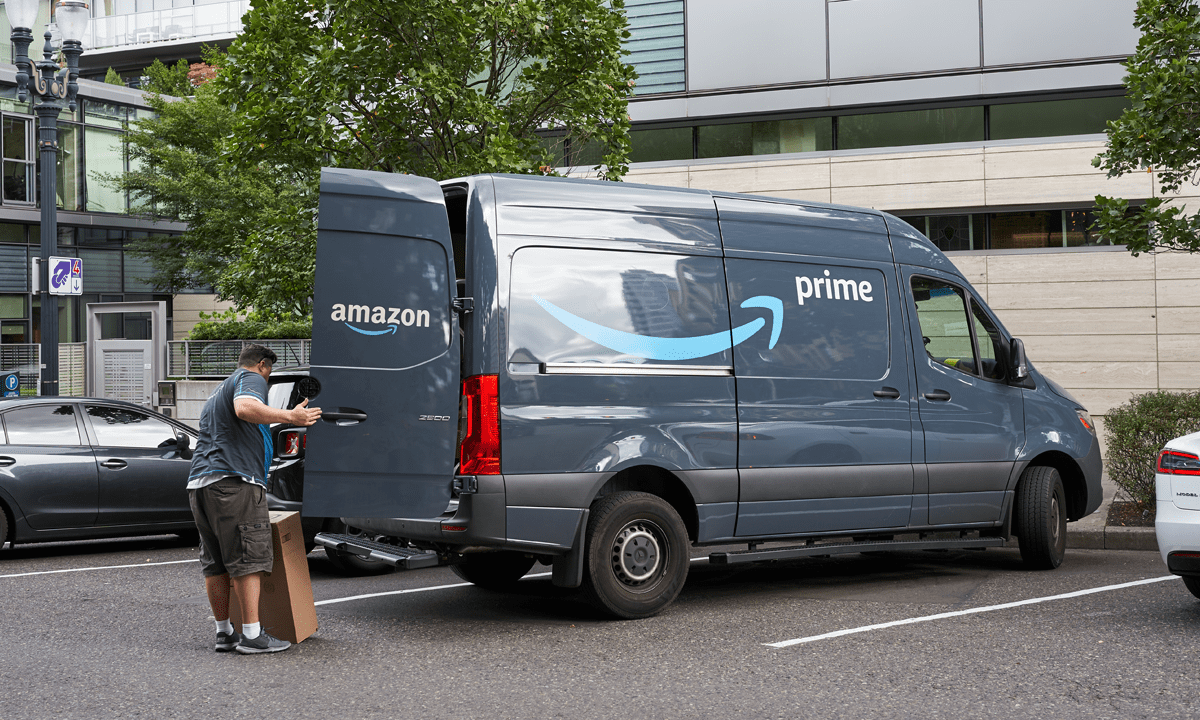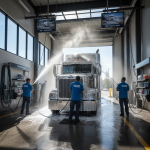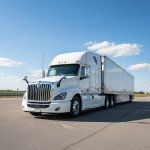With the rise in online shopping, efficient last mile delivery has become a priority for retailers like Amazon. As the demand for faster deliveries increases, so does the need to navigate through complex city and county guidelines. In this article, we will delve into the specifics of Amazon last mile delivery vehicles and help you understand the regulations that govern their operations.
Navigating the city and county guidelines is essential to ensure a smooth and compliant delivery operation. From vehicle size restrictions to noise level limitations, understanding these regulations is crucial for Amazon’s last mile delivery success. By complying with these guidelines, Amazon can ensure a seamless experience for its customers while minimizing any potential legal issues.
From understanding weight restrictions to identifying designated delivery zones, this article will provide valuable insights into the guidelines and regulations that impact Amazon’s last mile delivery operations. By gaining a comprehensive understanding of these guidelines, Amazon can optimize its delivery efforts, reduce delivery times, and enhance customer satisfaction.
Stay tuned to learn more about the different guidelines and regulations that impact Amazon’s last mile delivery vehicles, and how the company is working to overcome these challenges.
The importance of understanding city and county guidelines
When it comes to Amazon’s last mile delivery vehicles, understanding the city and county guidelines is of utmost importance. These guidelines are put in place to regulate and manage the flow of traffic, maintain safety standards, and minimize the impact of delivery operations on local communities.
By adhering to these guidelines, Amazon can avoid fines and penalties, maintain a positive relationship with local authorities, and provide a reliable and efficient delivery service to its customers. It also helps Amazon build trust and credibility with the communities it operates in, showcasing the company’s commitment to responsible and sustainable business practices.
City guidelines for Amazon last mile delivery vehicles
City guidelines for Amazon last mile delivery vehicles vary from one location to another. However, there are some common restrictions and regulations that are often applicable across different cities. These guidelines typically focus on aspects such as vehicle size, weight restrictions, parking regulations, and noise level limitations.
1. Vehicle Size Restrictions:
– Cities often have specific guidelines regarding the size of delivery vehicles that can operate within their limits. This includes restrictions on the length, width, and height of the vehicles.
– Amazon needs to ensure that its delivery vehicles comply with these size restrictions to navigate through narrow streets and congested areas without causing any disruptions.
2. Weight Restrictions:
– City guidelines also include weight restrictions for delivery vehicles. This is to protect the infrastructure, such as roads and bridges, from excessive wear and tear caused by heavy vehicles.
– Amazon must ensure that its delivery vehicles do not exceed the maximum weight limits set by the city authorities to avoid potential damage to the infrastructure and maintain road safety.
3. Parking Regulations:
– City guidelines often specify designated parking zones for delivery vehicles. These zones are strategically located to minimize traffic congestion and ensure efficient delivery operations.
– Amazon needs to familiarize itself with the parking regulations in each city it operates in to avoid parking violations and maintain a smooth flow of traffic.
4. Noise Level Limitations:
– To minimize noise pollution, cities enforce regulations on the noise levels generated by delivery vehicles, especially during late-night or early-morning hours.
– Amazon should invest in quieter vehicles or implement noise reduction technologies to comply with these regulations and minimize disturbances to local residents.
Understanding and adhering to these city guidelines is crucial for Amazon’s last mile delivery vehicles to operate smoothly and meet customer expectations. By complying with regulations, Amazon can avoid unnecessary legal issues and deliver a positive customer experience.
County guidelines for Amazon last mile delivery vehicles
Apart from city guidelines, Amazon also needs to navigate county guidelines that may have additional regulations specific to a particular region. These guidelines often focus on factors such as traffic flow management, road safety, and environmental considerations.
1. Traffic Flow Management:
– County guidelines may include restrictions on delivery vehicle routes to manage traffic flow efficiently. This can involve designating specific delivery corridors or implementing time-based restrictions to avoid peak traffic hours.
– Amazon should work closely with local authorities to understand and comply with these regulations, ensuring that its last mile delivery vehicles do not contribute to traffic congestion.
2. Road Safety:
– County guidelines prioritize road safety, and Amazon’s last mile delivery vehicles must meet certain safety standards. This can include regular vehicle inspections, ensuring proper maintenance, and adhering to speed limits and traffic laws.
– Amazon should establish robust safety protocols and training programs for its delivery drivers to ensure compliance with county guidelines and minimize the risk of accidents or injuries.
3. Environmental Considerations:
– Some counties may have specific regulations aimed at reducing the environmental impact of delivery vehicles. This can include requirements for low-emission vehicles or incentives for using electric or hybrid vehicles.
– Amazon should explore sustainable delivery options and consider incorporating eco-friendly vehicles into its fleet to align with these guidelines and contribute to environmental conservation efforts.
By understanding and complying with county guidelines, Amazon can operate its last mile delivery vehicles responsibly, minimizing their impact on traffic, ensuring road safety, and contributing to sustainable practices.
Common restrictions and regulations for Amazon last mile delivery vehicles
While city and county guidelines may vary, there are some common restrictions and regulations that Amazon’s last mile delivery vehicles often encounter. These regulations aim to strike a balance between efficient delivery operations and maintaining the quality of life for local residents.
1. Time Restrictions:
– Many cities and counties impose time restrictions on delivery operations, especially during peak hours or in residential areas.
– Amazon should plan its delivery routes and schedules accordingly, avoiding peak traffic times and ensuring that deliveries do not disturb residents during late-night or early-morning hours.
2. Designated Delivery Zones:
– To streamline delivery operations, cities may designate specific zones for commercial vehicle loading and unloading.
– Amazon should familiarize its delivery drivers with these designated zones to avoid unnecessary parking violations and ensure that deliveries are made in the most efficient manner.
3. Vehicle Design and Markings:
– Some cities and counties require specific vehicle markings, such as logos or identification numbers, to easily identify delivery vehicles.
– Amazon should ensure that its last mile delivery vehicles comply with these requirements to facilitate smooth interactions with local authorities and enhance security measures.
4. Insurance and Licensing:
– Delivery vehicles are often required to have appropriate insurance coverage and valid licensing to operate within city and county limits.
– Amazon should ensure that all its delivery vehicles are properly insured and licensed, providing necessary documentation as per the regulations to avoid any legal complications.
By understanding and adhering to these common restrictions and regulations, Amazon can optimize its last mile delivery operations, reduce delivery times, and enhance customer satisfaction.
Tips for complying with city and county guidelines
Complying with city and county guidelines may seem like a daunting task, but with the right approach, Amazon can ensure a smooth and compliant operation for its last mile delivery vehicles. Here are some tips to help navigate through the guidelines effectively:
1. Stay Updated:
– City and county guidelines are subject to change, so it is important for Amazon to stay updated with the latest regulations.
– Regularly check for updates on the websites of local authorities, participate in industry forums, and establish relationships with relevant city and county officials to stay informed.
2. Training and Education:
– Provide comprehensive training to delivery drivers on city and county guidelines, emphasizing the importance of compliance.
– Educate drivers on the specific regulations they need to follow in each city or county they operate in, ensuring they are aware of any recent changes.
3. Use Technology:
– Leverage technology solutions to optimize delivery routes, avoid restricted areas, and comply with time restrictions.
– Implement GPS tracking systems to monitor driver behavior and ensure adherence to speed limits and traffic laws.
4. Collaborate with Local Authorities:
– Establish open lines of communication with local authorities, building relationships and seeking guidance when needed.
– By proactively engaging with city and county officials, Amazon can address any concerns, clarify regulations, and work together towards a mutually beneficial solution.
By following these tips, Amazon can navigate the complexities of city and county guidelines more effectively, ensuring a smooth and compliant operation for its last mile delivery vehicles.
The benefits of adhering to city and county guidelines
Adhering to city and county guidelines for last mile delivery vehicles offers several benefits for Amazon:
1. Legal Compliance:
– By complying with regulations, Amazon can avoid fines, penalties, and potential legal issues, ensuring a smooth operation without interruptions.
2. Customer Satisfaction:
– Efficiently navigating through city and county guidelines allows Amazon to provide faster deliveries, enhancing customer satisfaction and loyalty.
3. Positive Community Impact:
– Adhering to regulations helps Amazon build trust and credibility within the communities it operates in, showcasing a commitment to responsible business practices.
4. Cost Efficiency:
– Complying with guidelines promotes efficient delivery operations, reducing fuel consumption, minimizing vehicle wear and tear, and optimizing overall costs.
By prioritizing compliance, Amazon can reap these benefits and establish a strong foundation for its last mile delivery operations.
Case studies of successful Amazon last mile delivery operations
To illustrate the effectiveness of complying with city and county guidelines, let’s explore two case studies of successful Amazon last mile delivery operations:
1. Case Study 1: Austin, Texas
– Amazon collaborated with local authorities in Austin to identify designated delivery zones and optimize delivery routes.
– By adhering to the guidelines, Amazon experienced a significant reduction in delivery times, leading to improved customer satisfaction and increased efficiency.
2. Case Study 2: Seattle, Washington
– Amazon implemented a fleet of electric vehicles in Seattle to comply with the city’s regulations on environmental sustainability.
– This initiative not only aligned with the guidelines but also showcased Amazon’s commitment to reducing its carbon footprint and contributing to a cleaner environment.
These case studies highlight how Amazon’s adherence to city and county guidelines can lead to successful last mile delivery operations, benefiting both the company and the communities it serves.
Resources for staying updated on city and county guidelines
Staying updated on city and county guidelines is crucial for Amazon to ensure compliance. Here are some resources that can help:
1. Local Government Websites:
– Visit the websites of city and county governments to access relevant regulations, updates, and contact information for local authorities.
2. Industry Associations:
– Join industry associations or organizations that provide updates on regulations and best practices for last mile delivery.
3. Networking Events:
– Attend networking events or conferences related to logistics and transportation to connect with professionals and gain insights on changing guidelines.
4. Consult with Legal Experts:
– Consider consulting with legal experts specializing in transportation regulations to ensure a thorough understanding of the guidelines and compliance requirements.
By utilizing these resources, Amazon can stay informed and adapt its last mile delivery operations to meet the evolving city and county guidelines effectively.
Conclusion: Ensuring a smooth and compliant operation for Amazon last mile delivery vehicles.
Navigating through city and county guidelines is essential for Amazon to operate its last mile delivery vehicles smoothly and efficiently. By understanding the regulations and complying with them, Amazon can avoid legal issues, enhance customer satisfaction, and contribute to positive community relationships.
From vehicle size restrictions to noise level limitations, complying with these guidelines requires proactive measures, continuous education, and technological solutions. By staying updated on the latest regulations, collaborating with local authorities, and prioritizing compliance, Amazon can optimize its last mile delivery operations and deliver an exceptional customer experience.
Remember, understanding and complying with city and county guidelines is not only a legal obligation but also an opportunity for Amazon to showcase its commitment to responsible and sustainable business practices. By embracing these guidelines, Amazon can continue to lead the way in efficient last mile delivery, setting industry standards for success.




